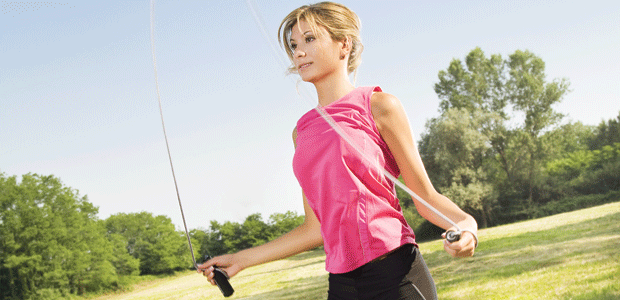
Skipping isn\’t just for kids. It provides a great workout, burning approximately 125 calories for 10 minutes of skipping exercise.
As a certified personal trainer, I attend fitness workshops to maintain my certification. I love this part of the job because it introduces me to new principles of training, keeps me current with the latest health and fitness research, and teaches me some cool exercises. So, a couple of years ago when I saw a workshop on skipping, I thought to myself, “Hey, that sounds like fun,” and signed up.
I still remember that skipping workshop. We skipped off and on for three hours, and during that time I kept thinking, “I may pay for this tomorrow.” That’s because any new stress on the body will show up the next day as muscle soreness, no matter what shape you are in—and skipping for 180 minutes was definitely a new stress for me. Sure enough, the next day I had to avoid all stairs for fear of ripping my tightened calf muscles. After I recovered, though, I was back on the rope.
Skipping is just the right mix of high-impact and high-intensity exercise, making it one of the best calorie-burning exercises. On average, a 150-pound person will burn about 125 calories for every 10 minutes of skipping (700 calories in one hour). That’s a lot of calories in a short amount of time. In fact, to get a comparable calorie burn rate you would need to walk briskly for 25 minutes, swim for 15 minutes, or ride a stationary bike for about 16 minutes.
Fitting your rope
- Stand on the middle of your jump rope and pull the handles up along your sides. The tips of the rope should reach your armpits.
- If the tips are past your armpits, adjust your rope by tying a loose knot around one handle. If one knot is not enough, tie another around the other handle.
Selecting your rope
- Beaded ropes, made of an inner cord strung with plastic or polyurethane segments, are popular because they are so durable. These ropes offer just the right amount of weight for beginners, as they won’t easily tangle around the feet. Beaded ropes are also recommended for children who are starting out.
- Leather ropes, which are also weighty enough to be manoeuvred easily, are a good choice for beginners.
- Speed ropes are light and fast and favoured by fitness enthusiasts, athletes, and boxers. They allow the highest number of turns per minute and provide the best opportunity to burn calories and raise heart rate. Beginners who will be jumping indoors would also benefit from a speed rope.
- Weighted ropes develop upper body muscle tone and endurance and are recommended for more advanced skippers.
Warming up
- Start with a 5 to 10 minute warmup by jumping without your rope, mimicking the movement with your arms and legs.
- Include arm circles, jumping jacks, and running on the spot to prepare you for skipping.
Working out
- Beginner: try Exercise 1 for 30 seconds, then march on the spot for another 30 seconds before continuing to Exercise 2. Perform the whole series of exercises this way.
- Intermediate: jump for 60 seconds and then perform jumping jacks for 30 seconds before progressing to the next exercise in the series.
- Advanced: perform each exercise for 60 seconds, proceeding through the whole routine without stopping. Rotate through as many cycles as you can.
- Option for all levels: turn your old weight training workout into a calorie-blasting circuit routine by incorporating skipping. After every third strength training exercise, add 30 to 60 seconds of skipping.
|
Exercise 1: Double foot jump |
| Exercise 2: Alternate foot jump
In this jump, one foot lands before the other with each turn of the rope. When you use this technique, make sure you alternate the foot that lands first so you don’t create a muscle imbalance by always landing on the same foot. |
| Exercise 3: Butt kicks
Keep your knees under your hips and kick your heels up to your buttocks as you skip. This movement will give the hamstring muscles a better workout. |
| Exercise 4: Running jump
While you’re skipping, focus on lifting your knees as if you’re running. This way you’ll place more emphasis on the front of your hips and your quadriceps. |
|
Exercise 5: Side-to-side jump Keeping feet together, jump side to side instead of landing in the same spot, like a slalom skier. This will work the outer hip muscles. |



































